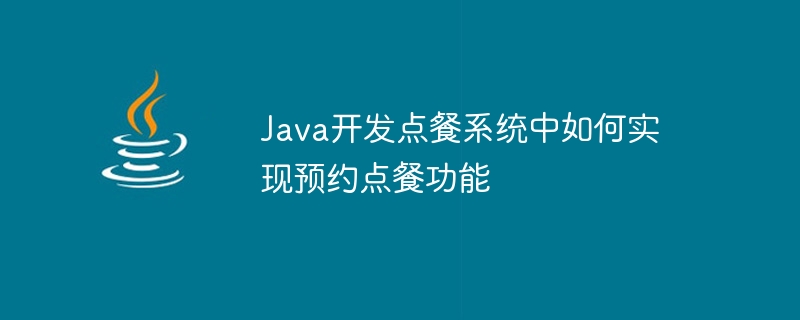

With the improvement of people's living standards and the enhancement of consumption awareness, more and more people choose to eat out instead of cooking at home. What follows is a problem faced by restaurant operators, that is, how to improve dining efficiency and avoid customers waiting too long. In response to this problem, many restaurants have begun to introduce the reservation and ordering function to reserve and arrange orders in advance. In the ordering system developed in Java, there are the following key points to implement the reservation ordering function.
First of all, the system needs to provide a convenient and fast reservation and ordering interface. In the ordering system, there is usually a client that provides customers with an interface for ordering and making reservations. This interface needs to be concise, clear, easy to operate, and allow customers to quickly select dishes and make reservations. Such an interface can be realized through Java technology, and an interface with a good user experience can be easily built using GUI libraries such as Java's Swing or JavaFX.
Secondly, the system needs to implement data storage and management of reservation orders. In the ordering system, each reservation order needs to be saved for management and processing. Java provides a variety of ways to store data. For example, you can use relational databases such as MySQL or non-relational databases such as MongoDB for data storage. Through Java's database connection technology and ORM framework, users' reservation orders can be conveniently stored in the database, and orders can be easily queried, modified, and deleted.
Next, the system needs to provide the function of managing reservation orders. For restaurant operators, they need to be able to easily view, process and count all reservation orders. The ordering system developed in Java can provide operators with a backend management interface, through which the management function of reservation orders can be realized. Through Java's web development technology, such as using the SpringMVC framework to build back-end services, functions such as user authentication, employee permission management, order query, and statistics can be easily implemented.
In addition, the system should also provide a reminder function for reservation orders. When the appointment time is about to arrive, the system can automatically notify customers through text messages, emails or APPs to remind them of the upcoming appointment time. This requires integration with third-party communication services. Technologies such as Java's SMS interface or the SMTP protocol of mailboxes can easily implement this function.
Finally, the system needs to ensure the security and stability of the reservation and ordering function. In the ordering system, users' personal information, order information, etc. are sensitive information and need to be properly protected. Java provides a variety of security mechanisms to encrypt, transmit and store users' sensitive information. In addition, the system needs to be deployed on a stable and reliable server to ensure that users can use the reservation and ordering function anytime and anywhere.
To sum up, implementing the reservation ordering function in a Java-developed ordering system requires consideration of interface design, order storage and management, background management functions, reminder functions, security and stability, etc. By rationally using Java technology and related frameworks, a fully functional, safe and stable reservation and ordering system can be realized to meet the needs of restaurant operators to improve dining efficiency and enhance users' dining experience.
The above is the detailed content of How to implement reservation ordering function in Java development ordering system. For more information, please follow other related articles on the PHP Chinese website!
 jquery validate
jquery validate
 What do e-commerce platforms include?
What do e-commerce platforms include?
 How is the performance of thinkphp?
How is the performance of thinkphp?
 How to register for corporate Alipay
How to register for corporate Alipay
 How to set html scroll bar style
How to set html scroll bar style
 The difference between fprintf and printf
The difference between fprintf and printf
 What's going on with the red light on the light signal?
What's going on with the red light on the light signal?
 Eth price today's price trend
Eth price today's price trend
 The difference and connection between java and javascript
The difference and connection between java and javascript




